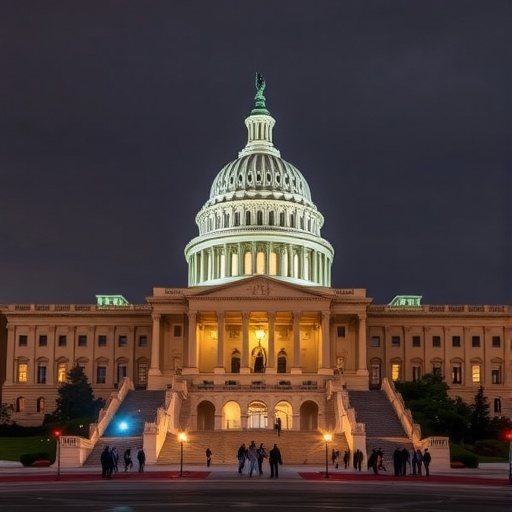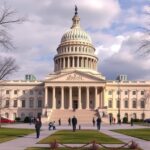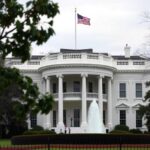U.S. Government shutdown Surpasses 21 Days: Senate Deadlock Leaves 750,000 Federal Employees Stranded in Political Limbo
In a stark display of Washington gridlock, the U.S. federal Government shutdown has dragged into its 21st day, marking one of the longest such standoffs in American history. With over 750,000 federal employees furloughed or working without pay, essential services from national parks to air traffic control are teetering on the brink, all while Senate negotiations remain mired in partisan discord. This escalating crisis, rooted in battles over border security funding, threatens to upend daily life for millions across the USA and ripple through the global economy.
- Federal Workers Grapple with Holiday Heartbreak and Empty Pockets
- Essential Services Buckle Under Shutdown Strain Nationwide
- Senate Showdown: Partisan Clashes Over Border Wall Funding Intensify
- Economic Fallout Echoes Through Businesses and Global Markets
- Pathways to Resolution: Bipartisan Breakthroughs and Looming Deadlines
Federal Workers Grapple with Holiday Heartbreak and Empty Pockets
As families gather for the holidays, the shutdown’s human toll hits hardest among the federal employees caught in its crossfire. More than 750,000 workers—ranging from Smithsonian curators to IRS auditors—face the grim reality of missed paychecks, with no end in sight. “It’s like living in a bad dream,” said Maria Gonzalez, a 15-year veteran at the National Park Service, who has been furloughed since the shutdown began on December 22. “We’re essential to the country, but right now, we’re invisible to the politicians causing this mess.”
The financial strain is immediate and severe. Furloughed employees, numbering around 380,000, are prohibited from working, while the remaining 370,000 deemed essential continue their duties without compensation guarantees. According to the Office of Personnel Management, these workers span 57 departments and agencies, from the Department of Defense to the Environmental Protection Agency. Many are dipping into savings or relying on food banks; a survey by the National Treasury Employees Union revealed that 40% of affected workers have less than $1,000 in emergency funds.
Personal stories underscore the shutdown’s emotional weight. In Virginia, a hub for federal jobs, single mother and Coast Guard technician Jamal Reed shared his plight: “My kids don’t understand why Santa might be light on gifts this year. This isn’t just politics; it’s our survival.” The ripple effects extend to contractors and vendors, potentially costing the economy $1.5 billion per week, per estimates from the Congressional Budget Office. As the U.S. Government shutdown persists, these workers’ resilience is tested, highlighting the human cost of Capitol Hill’s impasse.
Essential Services Buckle Under Shutdown Strain Nationwide
Beyond the payroll crisis, the government shutdown is disrupting core functions that Americans rely on daily. National parks, monuments, and museums remain shuttered, depriving the tourism industry of vital revenue—losses already topping $100 million in the shutdown’s first two weeks, according to the U.S. Travel Association. Yellowstone and Yosemite, typically bustling with winter visitors, stand eerily empty, with rangers like Gonzalez sidelined despite ongoing maintenance needs.
Air travel, a lifeline for holiday reunions, faces heightened risks as understaffed Federal Aviation Administration teams handle increased workloads. The Transportation Security Administration reports longer lines and fatigue among screeners working without pay, leading to a 20% uptick in delayed flights at major hubs like Atlanta and Los Angeles. “Safety is our priority, but exhaustion is real,” noted TSA spokesperson Mike McCarthy in a recent briefing.
Food safety inspections have also faltered, with the FDA halting routine checks on imported seafood and produce, raising concerns about potential health outbreaks. In the heartland, farmers await delayed loan approvals from the USDA, stalling planting seasons and exacerbating rural economic woes. Meanwhile, Smithsonian Institution closures have canceled educational programs for thousands of schoolchildren, turning what should be a season of learning into one of lost opportunities.
These disruptions aren’t confined to Washington; they echo across the USA, from delayed veterans’ benefits in California to paused wildlife conservation in Alaska. The shutdown’s scope— the longest since the 1995-96 impasse under President Clinton—serves as a reminder of how federal employees‘ absence cascades into everyday inconveniences and broader vulnerabilities.
Senate Showdown: Partisan Clashes Over Border Wall Funding Intensify
At the epicenter of this chaos is the Senate, where Democrats and Republicans remain deadlocked over President Trump’s demand for $5.7 billion in border wall funding. The impasse began when Congress failed to pass a spending bill by December 21, triggering automatic shutdown protocols under the Antideficiency Act. Senate Majority Leader Mitch McConnell (R-KY) has blocked multiple Democratic attempts to advance clean funding resolutions, insisting on tying relief to immigration reforms.
“We cannot reward lawlessness with open borders,” McConnell declared on the Senate floor last week, echoing the president’s stance. Democrats, led by Minority Leader Chuck Schumer (D-NY), counter that the wall is an ineffective symbol, pointing to studies from the Government Accountability Office showing that barriers cover only a fraction of the 2,000-mile border and fail to address root causes like visa overstays.
Negotiations have sputtered despite backchannel talks. A bipartisan group of senators, including Lindsey Graham (R-SC) and Dick Durbin (D-IL), proposed a compromise including $1.6 billion for wall prototypes and enhanced technology, but it was shot down amid accusations of capitulation. House Speaker Nancy Pelosi (D-CA) has urged the Senate to act independently, passing four funding bills in the lower chamber that now languish in the upper house.
The political theater has drawn sharp rebukes. Former President Barack Obama tweeted, “This shutdown is a self-inflicted wound on the American people, driven by extreme ideology over common sense.” Polls from Quinnipiac University show 52% of voters blame Republicans, with approval for the president’s handling of the crisis at a dismal 29%. As politics in the USA polarizes further, the Senate‘s inability to break the deadlock prolongs the pain for everyday citizens.
Economic Fallout Echoes Through Businesses and Global Markets
The government shutdown‘s tentacles reach far beyond federal offices, squeezing small businesses and unsettling international markets. Wall Street has felt the tremors, with the Dow Jones dropping 1.2% in the past week amid fears of prolonged uncertainty. Economists at Moody’s Analytics project a 0.1% GDP hit for every week of shutdown, potentially shaving $18 billion off the U.S. economy by January if unresolved.
Small enterprises near federal sites are reeling. In the Washington, D.C., area, restaurants and hotels report a 30% revenue dip as federal employees tighten belts. “Our lunch crowd vanished overnight,” lamented owner Sarah Kim of a Capitol Hill deli, which has laid off five staffers. Nationally, the National Restaurant Association estimates $3 billion in lost sales during the holiday season alone.
Globally, the shutdown undermines U.S. credibility. Trade partners like China and the EU watch warily as delayed regulatory approvals stall exports—agricultural shipments worth $1.3 billion are backed up at ports due to unpaid customs inspectors. The World Bank has flagged the crisis as a risk to emerging market stability, given America’s role as the world’s largest economy.
Yet, some sectors adapt. Private contractors are stepping in for services like IT support, while nonprofits fill gaps in food assistance programs. Still, the broader politics of division amplifies economic anxiety, with consumer confidence indices plummeting to levels not seen since the 2013 shutdown.
Pathways to Resolution: Bipartisan Breakthroughs and Looming Deadlines
As the government shutdown enters uncharted territory, glimmers of hope emerge amid the frustration. White House officials hint at renewed talks post-New Year’s, with Vice President Mike Pence scheduled to meet Senate leaders this week. A potential compromise could involve phased funding: immediate relief for federal employees paired with border security investments below the president’s ask.
Advocacy groups push for urgency. The Partnership for Public Service, representing 200,000 workers, has launched a “Pay Our Federal Family” campaign, garnering support from 150 business leaders urging Congress to prioritize back pay in any deal. Legal experts note that while furloughed employees are entitled to retroactive pay upon resolution, the delay compounds interest on loans and credit hits.
Looking ahead, the January 3 swearing-in of new House members could shift dynamics, with Democrats holding a slim majority. Analysts predict a February 15 debt ceiling deadline might force action, as default risks loom larger than wall debates. International pressure mounts too; the IMF has warned of spillover effects on global growth.
For the 750,000 federal employees and millions affected, resolution can’t come soon enough. As one anonymous Capitol staffer put it, “This isn’t sustainable. The USA‘s strength lies in unity, not shutdowns.” Whether Senate pragmatism prevails or politics prolongs the pain, the coming weeks will test the resilience of American governance. Stakeholders from labor unions to Wall Street watch closely, hoping for a swift end to this holiday-season ordeal.









